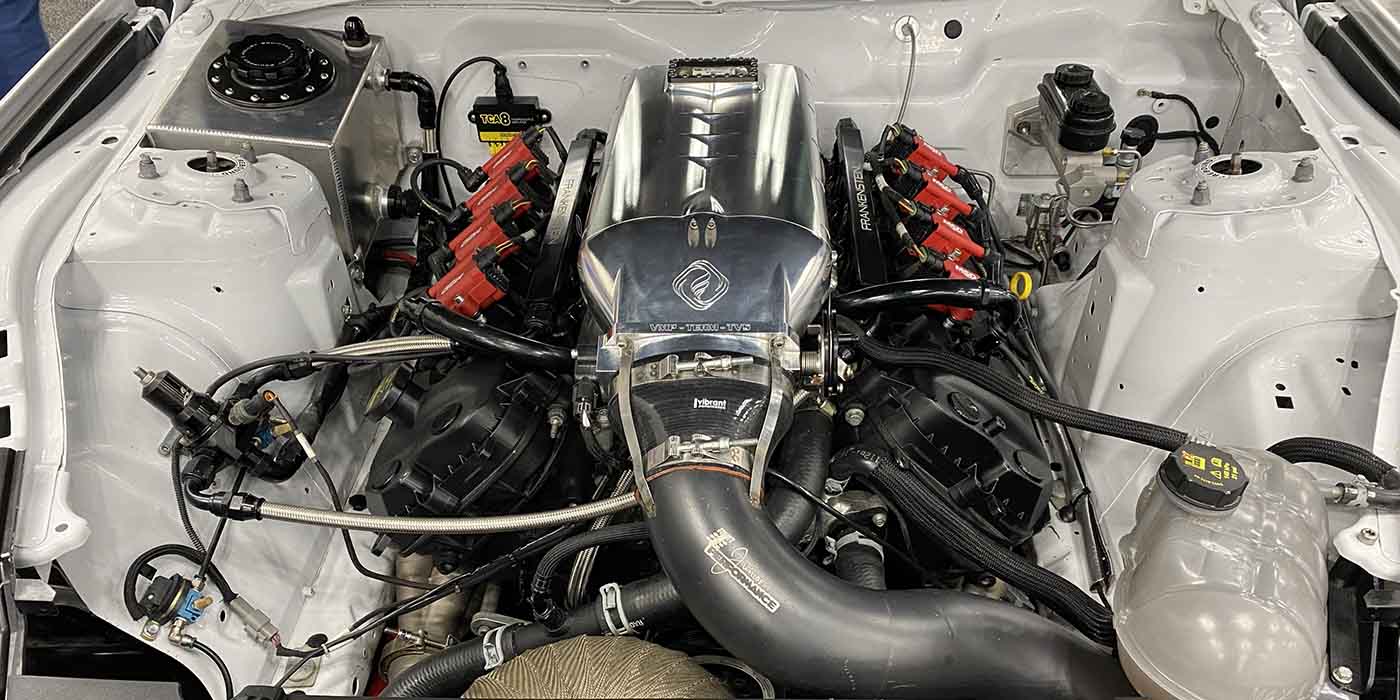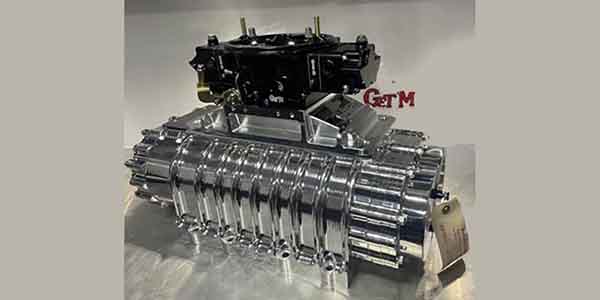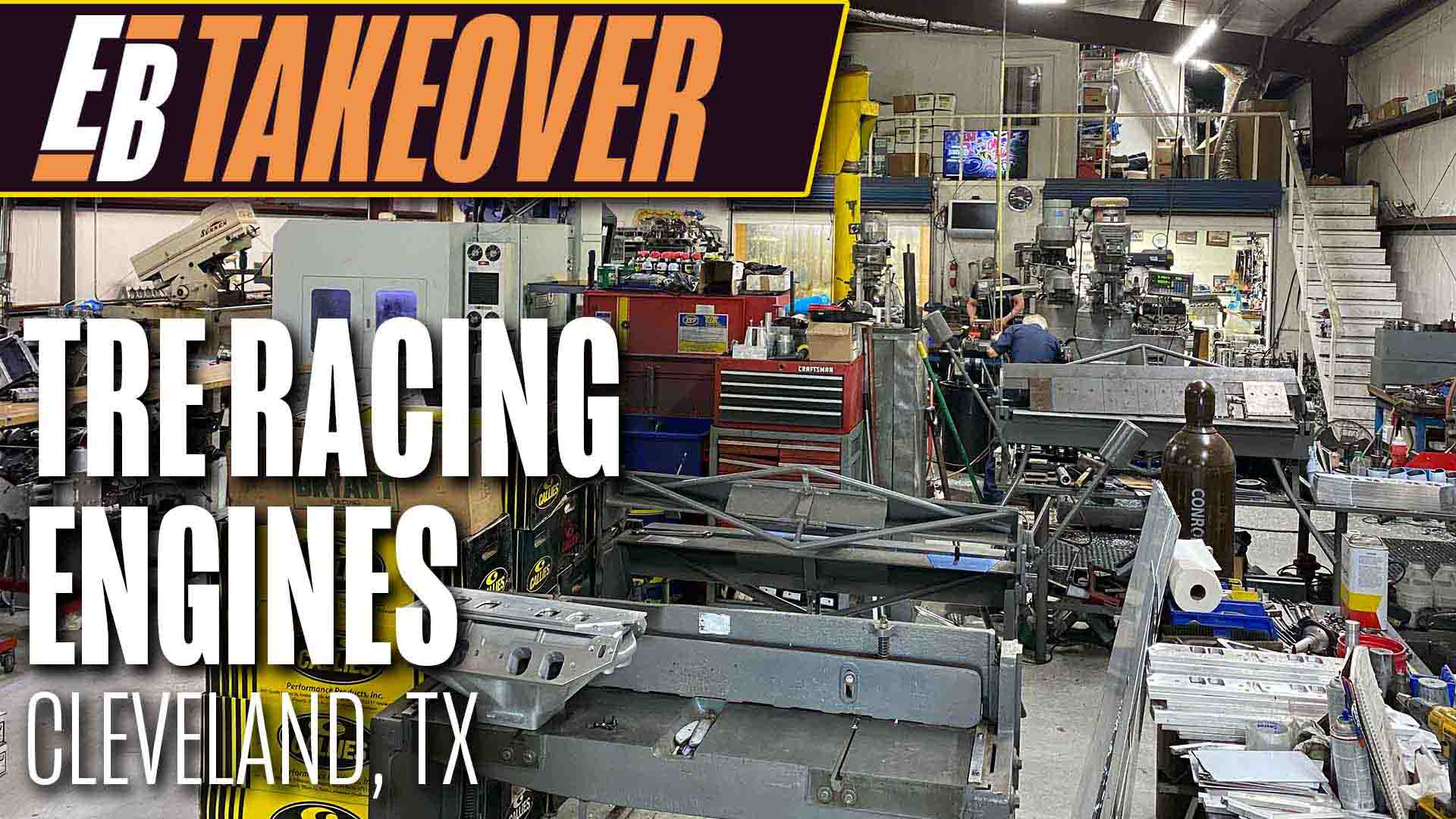The engine can only inhale so much air because the atmospheric force that’s pushing air into the engine is only 14.7 lbs. per square inch at sea level. To make matters worse, atmospheric pressure decreases with elevation. Air density also decreases with temperature because hot air is thinner than cold air.
Most stock naturally aspirated engines only achieve a peak volumetric efficiency of 75 to 85 percent.
Multiple valves per cylinder and variable valve timing help improve breathing efficiency in late model engines, but if you’re building a small block or big block Chevy, Ford or Chrysler engine, you’re usually limited to two valves per cylinder and fixed valve timing.

more instant throttle response
depending on the type of supercharger
that is used.
Even so, there are still a lot of tricks you can do to improve air flow and volumetric efficiency in a naturally aspirated engine such as the following:
• Installing a higher lift, longer duration camshaft.
• Modifying the stock heads or replacing them with aftermarket performance heads that have larger valves and better ports.
• Installing an intake manifold with taller and longer runners to help ram more air into the cylinders.
• Installing a larger throttle body or carburetor (or multiple carburetors) that can flow more CFM (cubic feet per minute)
• Adding an air scoop or cold air intake system to help route cooler denser air into the engine.
• Improving exhaust scavenging with headers and crossover pipes that help improve air flow out of the cylinders.
With such improvements, it is possible to boost an engine’s volumetric efficiency into the 90 percent range or even higher. But achieving 100 percent or higher volumetric efficiency (especially at higher rpms) usually requires some type of forced induction system such as a turbocharger or supercharger.
A forced induction system overcomes the limitations of atmospheric pressure by pushing more air into the cylinders. Consequently, the engine’s power output becomes a function of how much boost it gets. What’s more, dialing up the boost pressure overcomes a lot of deficiencies in the induction system and cylinder heads that would otherwise limit air flow and the engine’s volumetric efficiency. After all, it is much easier to push air into an engine with a turbo or blower than to suck it in with intake vacuum alone.
Even with a relatively moderate amount of boost, say 6 to 8 psi, a forced induction system can easily increase the power output of a typical street engine 150 or more horsepower. Turn up the boost pressure to 14 to 16 psi and you can usually double the power output of most engines. Crank it up even more and you’re off to the races. The challenge then becomes building the engine so it can safely handle the extra power without breaking something (which we will get to shortly).
Forced Induction
A turbocharger uses hot exhaust gases to spin a turbine wheel that is connected by a short shaft to an impeller wheel inside the compressor housing. The impeller sucks air into the turbo housing, compresses it and pushes it into the engine to create boost pressure. As it is compressed, the air gets hot (sometimes excessively so), so the air exiting the turbo is usually routed through an air-to-air or air-to-water heat exchanger called an “intercooler.” Boost pressure is controlled by a “waste gate” that opens to vent pressure once a certain level of boost has been achieved.
Turbos spin at extremely high speeds – up to 100,000 rpms or faster when they are making peak boost pressure. But to achieve such speeds, it takes more exhaust flow from the engine. So instant throttle response is not one of the advantages of a turbocharger. Most turbos don’t develop much boost pressure until the engine is turning 2,500 rpm or higher. Then the turbo comes on like gangbusters and starts making all kinds of power.
Turbo kits are available for many popular applications and greatly simplify installation issues by providing all of the hardware and plumbing that is needed to fit a particular vehicle, including higher flow fuel injectors, a higher flow fuel pump in some cases and a special tuner tool for recalibrating the ECM.
Supercharging, by comparison, typically provides more instant throttle response depending on the type of supercharger that is used. A supercharger is a belt-driven blower so it is somewhat less efficient than a turbo because it saps power from the engine to drive the blower. A turbo gets its drive energy for free from the exhaust but also creates a small amount of power-reducing backpressure that has to be overcome before it develops boost and starts to make power.
A “positive displacement” supercharger (also called a “Roots” style blower) like that on the ZR1 Corvette, GT 500 Shelby Mustangs, Roush Mustangs, many street rods, Alcohol and Top Fuel dragsters, has counterrotating lobed rotors that force air into the engine. The boost pressure developed depends on engine speed and the underdrive ratio of the pulley on the supercharger.
By comparison, a “centrifugal” supercharger like those made by Paxton, ProCharger and Vortex, does not have counterrotating rotors but uses a compressor design similar to the impeller wheel on a turbocharger. Boost builds with rpm more like a turbo, but throttle response is better because of the belt-drive setup.
Supercharger kits are available for many popular street engines and typically offer a boost in performance of 150 to 200 or more horsepower – which most stock blocks can handle without having to make any additional modifications. But with higher levels of boost, things start to break and additional modifications become necessary to maintain engine reliability.
Air & Fuel Limitations
Another factor that limits an engine’s power potential is the air it breathes. Only 21% of the air that the engine pulls in contains oxygen, which is the essential ingredient that’s needed for combustion and power. Seventy-eight percent of the air is nitrogen and adds nothing to the combustion process (except NOx pollution at elevated temperatures).
Consequently, the power potential of an engine (whether it is naturally aspirated or boosted) is limited by the air and fuel it burns.
Higher octane gasoline contains the same energy content as lower octane gas, but it can handle higher compression ratios that improve combustion efficiency and power. Alcohol fuels such as methanol and ethanol actually contain LESS energy content than gasoline (57,000 BTUs for methanol and 76,000 BTUs for ethanol versus about 114,000 BTUs for gasoline) but are good racing fuels because they can handle higher compression ratios and contain additional oxygen that adds to combustion efficiency.
Alcohol fuel mixtures have to be almost twice as rich as those for gasoline. This decreases an engine’s volumetric efficiency slightly because the extra fuel displaces air, but also allows the engine to make about 10 percent more power if the engine is built to optimize performance on alcohol fuel.
Adding a nitrous oxide system (NOS) to an engine overcomes the limitation of how much oxygen is in the air by adding more oxygen to the combustion process. This allows the engine to burn a much richer fuel mixture to make more power. Think of it as a poor man’s alternative to nitromethane racing fuel, which does the same thing only in a much more dramatic fashion.
When nitrous oxide (N2O) is injected into an engine, the heat of combustion breaks down the N2O into nitrogen and oxygen, increasing the free oxygen that’s available for further combustion. This would have a leaning effect on the air/fuel mixture, so additional fuel must also be injected into the engine at the same time to take full advantage of the extra oxygen. The amount of power added will depend on the “shot” of nitrous that is sprayed into the engine. For mild street performance, the shot might only add 50 to 100 horsepower, but for more serious competition the boost might be 200 horsepower or higher.
Another cool thing about nitrous systems is that they can be added to any kind of engine (naturally aspirated, turbocharged or supercharged) and used with carburetors or electronic fuel injection. Another advantage is that nitrous provides power in a short burst only when it is needed, so there is less overall strain on the engine than what would be normal with a typical forced induction system. However, when the power does come on, it comes on hard and fast so the engine has to be durable enough to handle the sudden jump in cylinder pressure and heat.
Engine Modifications
Whenever you’re building an engine for a customer that will employ some type of power adder (turbo, blower or nitrous), at some point major upgrades or modifications will become necessary to safely handle the increase in power. What mods and how much will depend on the engine and the application. Street engines spend most of their time running under relatively light loads and only occasionally are called upon to produce maximum power.
But they are expected to last tens of thousands of miles without any major problems. An engine that’s going into a drag car or some other type of race car, on the other hand, may not rack up a lot of miles in a season but the miles it runs will be hard miles at full throttle under heavy load. So it can be argued that engine durability is just as important for both types of power adder applications.
The upgrades that are necessary to handle power adders will depend on the engine and the power level the engine is built to produce. For a typical street application, changes to the stock pistons, rods and crankshaft are usually unnecessary unless a customer wants to make insane levels of power. Most stock block V8s can safely handle 150 to 200 extra horsepower on the street without encountering any major problems.
When an engine’s power output exceeds about 600 horsepower with a small block, or 800 horsepower with a big block, upgrades start to become mandatory with power adders. Upgrades like forged pistons, steel top rings, stronger connecting rods and a forged steel 4340 crankshaft become necessary to handle the increased loads. Increased cooling capacity also becomes important. The more power an engine makes, the more waste heat the cooling system must manage without allowing the engine to overheat. A high flow water pump, efficient cooling fan and larger thicker radiator may be required.
Durability can vary quite a bit depending on the engine, say turbo and supercharger experts. Many late model Chevy LS engines can safely handle up to 1,000 horsepower before things start to break. But the Ford 4.6L three-valve engine is good for only about 500 horsepower at the wheels. Beyond that you start breaking rods. Ford’s new 5.0L Coyote engine is much stronger and can take up to 700 horsepower.
As a rule of thumb, says one expert, older small block Chevy and Ford engines usually require a forged steel crank, stronger H-beam connecting rods and forged pistons if you are going to push them beyond 600 to 700 horsepower. You also have to open up the piston ring end gaps a bit to handle the extra heat.
As for compression ratios, it depends on the type of fuel. Higher octane racing gas or alcohol can safely handle more compression. Up to about 14 to 16 psi of boost, you can run 9:1 or 9.5:1 compression with an intercooler and aluminum cylinder heads. With a fuel like Q16 racing gas (octane rating 117), one supplier says you can run compression ratios as high as 11 to one and up to 25 to 30 psi of boost. However, he says you also want more cam lobe separation, too.
ProLine Racing in Ball Ground, GA, specializes in building high output twin turbo engines for drag cars and high end exotic cars, some of which are running up to 50 psi of boost on alcohol and making upwards of 4,000 horsepower! General manager Matt Petka says all of the engines they build today are fuel injected because they are more easily tunable than carburetors. “We’ve converted a lot of drag racers who were running nitrous oxide to turbos because of the many advantages turbos can provide. We can build a 3,000 horsepower turbo drag motor that can go 100 runs before the engine needs anything other than maybe fresh valve springs.”
What sort of upgrades does Petka make in the high output turbo engines his shop builds? He says a forged or billet crank is a must. For engines that develop 1,000 to 2,000 horsepower, he uses standard high performance cranks. For high power levels, he goes with a custom billet crankshaft.
Petke says aircraft quality steel rods are a good upgrade for engines up to about 1,000 horsepower, and he uses performance rods in many street engines. For pistons, he goes with hard anodized forgings and usually keeps the compression ratio to 9.5:1 or less (depending on the fuel used). On engines that make over 1,000 horsepower, he goes with custom pistons and a larger diameter wrist pin.
To handle the extra heat in the combustion chamber, Petke uses Inconel exhaust valves and copper-beryllium valve seats. He also uses steel exhaust guides with bronze liners.
John Balinsky of OAB Racing in Island Park, NY, says he recommends a 4340 forged steel crank for any power boosted engine that makes over 800 hp, and a billet crank for any engine over 1,500 hp. “Up to about 600 hp, you can get by with most stock rods, but after that you need at least an entry level performance rod. Beyond 1,200 hp, I’d recommend Oliver or Carrillo steel rods or aluminum rods.”
Balinsky said he would never use any type of cast piston in a boosted engine. Forged pistons are the only way to go because of their strength and their ability to dissipate heat better than a cast piston. He also recommends a hard anodized coating on the pistons for drag racing.
“I would also recommend paying close attention to bearing clearances. Don’t build the engine too tight. On highly boosted engines, the bearings should be run a little looser. Also use a heavier viscosity motor oil such as 20W-50 for the street or a straight 50 for drag racing.”
The advice given by these experts is similar to that for building most high performance engines whether they are naturally aspirated or force fed. As power goes up, so does the need for stronger parts to maintain durability. Anybody can throw together a highly boosted engine that makes gobs of horsepower. But how long will that engine last if the quality of the parts that went into it are not up to the task? The price of durability doesn’t come cheap, so don’t cut corners when choosing your parts.
[inpost_gallery thumb_width=”200″ thumb_height=”200″ id=”” random=”0″ group=”1″ border=”” thumb_margin_left=”3″ thumb_margin_bottom=”0″ thumb_border_radius=”2″ thumb_shadow=”0 1px 4px rgba(0, 0, 0, 0.2)” js_play_delay=”3000″ post_id=”3362″ type=”yoxview” sc_id=”sc1389907715747″]
For a list of suppliers of performance power adders, check out the High Performance Buyers Guide.













